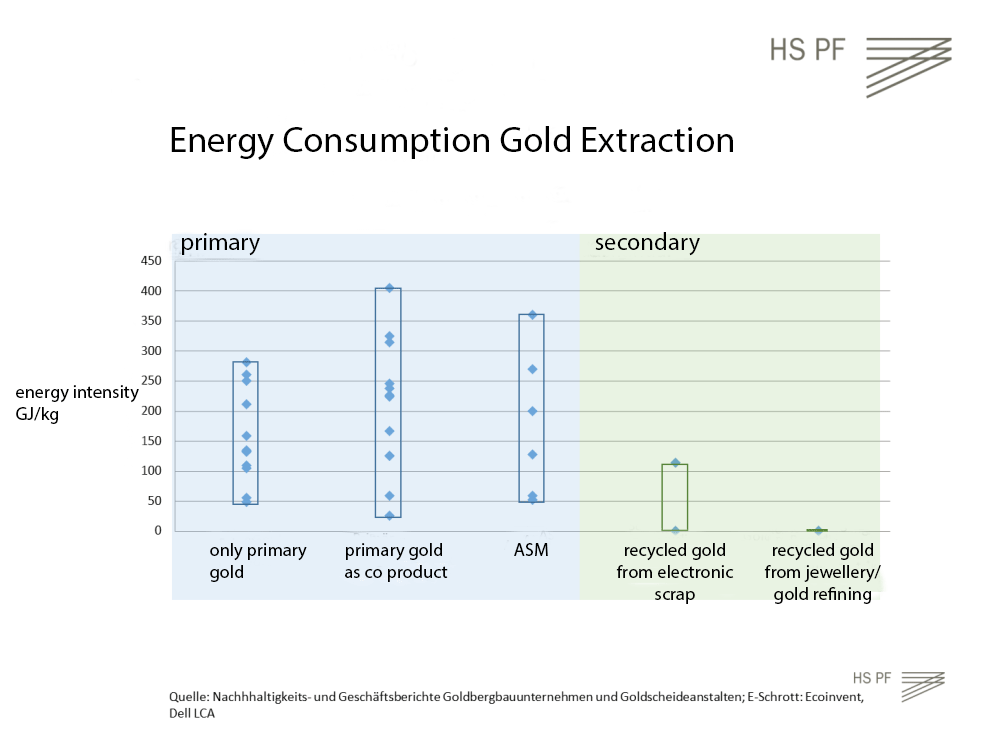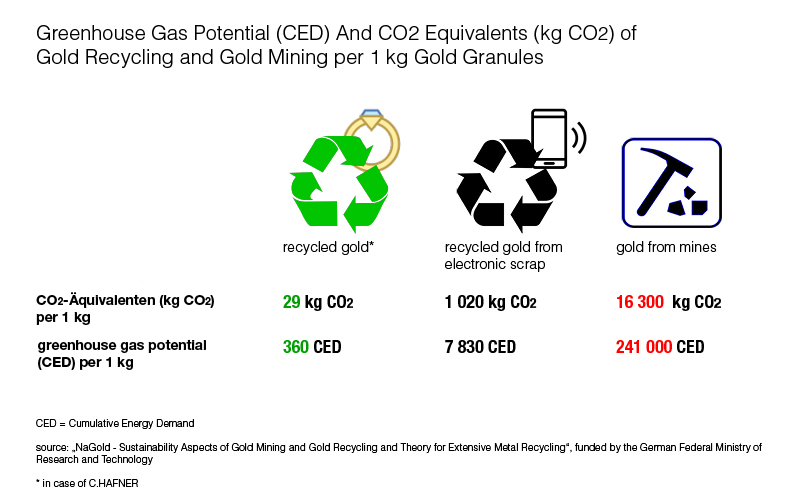In recent decades, the focus in regards to supply chains has predominantly been on human rights with the key phrase being „conflict resources“. Using the OECD guidelines, industrial organizations, such as the London Bullion Market Association (LBMA) or the Responsible Jewelry Council (RJC), have defined processes that, when audited, provide protection against the violation of human rights in the extraction and processing of gold. What was previously less in focus is the question of the effects on nature and climate.
It is well known that gold mining is associated with significant land consumption and, in part, with significant pollution of land, air and water. However, the impact of gold mining on the ecological footprint has been neglected and has in no way affected the issue of certification. This is set to change, though, as climate protection and the question of the carbon footprint shift to the center of public awareness.
As there have been no studies on the sustainability aspects of secondary gold, process data on the recycling of scrap gold has been collected within the scope of the project „NaGold – Sustainability Aspects of Gold Mining and Gold Recycling and Theory for Extensive Metal Recycling“, funded by the German Federal Ministry of Research and Technology, in order to be able to make life-cycle comparisons. As a reference or so-called „functional unit“, to which all analyzes and results refer, 1 kg of gold granules was chosen. C.HAFNER, as a leading gold and silver refinery, has provided its process data for the survey. The process route for gold recycling was chosen as a system boundary, which includes various processes at different locations in the Pforzheim area. In addition, the so-called upstream chains and preliminary work were included. With the newly collected data, it is possible to specify the carbon footprint (CF), namely the greenhouse gas potential of gold recycling.
Gold Recycling versus Gold Mining
Before going into the study, the difference between types of gold should be clarified. The first type of gold is primary gold, which is also known as mine gold; this term denotes gold which is being extracted in mines. The second type of gold is called secondary gold or recycled gold. Since precious metal can be re-melted as often as desired, old gold from jewelry, dental gold and other sources can be processed in a gold and silver refinery and returned to the recycling cycle. Accredited gold and silver refineries can analytically exclude primary gold prior to further processing.
Life cycle assessments are usually based on primary gold, leading to a very poor ecological image of gold. Even with secondary gold, there are big differences. The previous focus was on gold from electronic scrap which leads to a further distortion (see table „energy consumption gold extraction“). Consequently, it is very important to distinguish between the different origins of gold in the life cycle assessment.

Results Of The Study: Ecological Footprint Of Gold In Comparison
The study involved the recovery of 1kg of fine gold granules from refinery scrap obtained by hydrometallurgical treatment after melting scrap gold.
The underlying energy and mass flows of the individual processes were summarized in a life cycle inventory. Pre-chains or pre-services beyond C.HAFNER were drawn from generic LCA databases (Life Cycle Assessment). For example, the CO2 emissions from power generation or the production of auxiliary and operating materials were also taken into account.
The evaluation of the study showed that the greenhouse gas potential of gold recycling at C.HAFNER is 29 CED, and the CO2 equivalent is 29kg. This raw data is unrelated and, thus, difficult to classify. However, if these numbers are compared with values from gold mining, the benefit of recycling becomes clear.

In various studies published by the WGC (World Gold Council) and others, the CO2 equivalents of gold mining between 11,500 kg and 55,000 kg were determined, signaling that fine gold recycled by C.HAFNER provides a lower carbon footprint than primary gold by a factor of 400-2,000. At C.HAFNER, we feel this is significant!
And Now? How Does This Effect The Ecological Footprint?
The results of this study provide a very good guideline for more sustainable action. The evaluation of the energy and material flow model by CO2 equivalents resulted in an allocation of 15 kg CO2 Eq. and 29 kg CO2 Eq. respectively after monetary value.
With the knowledge of the ecological footprint for gold recycling, the separation process can now be operated by appropriate CO2 neutralizing measures, thus CO2 neutral.
In return, C.HAFNER, in cooperation with the climate protection organization myClimate, is supporting a composting plant in the gold mining country of Indonesia. The plant composts organic waste which was deposited beforehand. As a result, methane gas emissions can be avoided and high-quality compost produced.
C.HAFNER is taking this first step as an opportunity to work on the CO2 neutrality of the entire company in the mid-term. We believe that in this way we can make a worthwhile contribution to climate protection.
